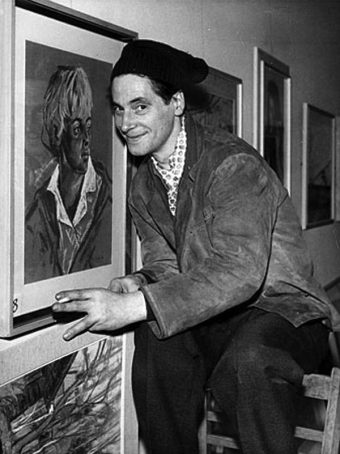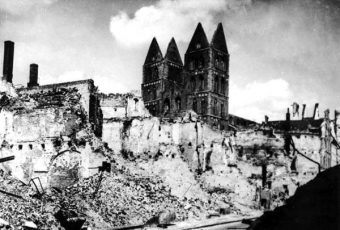Here’s the bizarre story of an anonymous artist so desperate to receive credit for his work that he took himself to court.

THE MIRACLE OF MARIENKIRCHE
On March 28, 1942, the German port city of Lübeck was nearly obliterated by Allied bombers during World War II.
More than 230 British planes dropped 400 tons of bombs, destroying thousands of homes, the town hall, the merchant district, and several churches dating back seven centuries, including the huge Gothic cathedral known as the Marienkirche (Church of Mary).The bombing created a firestorm so hot that the church bells melted. After the raid ended and townspeople began to assess the damage, a remarkable discovery was made in the Marienkirche. The intense heat had also melted dozens of layers of paint off the walls. Underneath that paint: frescoes, a style of painting in which pigment is applied directly onto a wet plaster wall. The paintings of saints, biblical scenes, and religious icons dated back to the 1250s, when the church was built. After what was dubbed “the miracle of the Marienkirche,” the town quickly came together to erect a temporary roof for the cathedral to protect it from further attacks, so that the frescoes could be restored when the war was over…whenever that might be.
FEY TO GO

After the end of the war in 1945, the roof and walls of the Marienkirche were rebuilt, and the work was completed in 1948. Town officials then hired celebrated German art restorer Dietrich Fey to bring the church’s frescoes back to life. Fey had apprenticed under his father, Ernst Fey, a Berlin art historian who had worked on the recovery and restoration of frescoes in churches throughout Germany in the 1920s and 1930s. But it was the elder Fey who was the artist; the younger Fey’s skills were more on the business side, landing commissions and finding wealthy patrons.
By 1936 the Feys had more work than they could handle, and they needed a skilled assistant. That’s when they were approached by Lothar Malskat. A recent graduate of the Art Academy of Konigsberg (now the Russian city of Kaliningrad), Malskat could paint in any number of classic styles. (His favorite style: 13th-century Gothic painting, like the frescoes of the Marienkirche.) Malskat had hoped to become an artist, but when he got to Berlin, the only painting work he could get was painting houses. He was homeless and sleeping on a park bench when he asked the Feys for a job.
BRICK HOUSE
Malskat’s first assignment: paint Dietrich Fey’s house. But Fey also brought Malskat into the restoration business, loaning books on ecclesiastical art (religious paintings), and training him as they worked. Malskat proved his talent in the 1937 restoration of St. Petri-Dom, a cathedral in the city of Schleswig with artworks dating to the 14th century. At first, he had to undo damage caused by the Feys. Then they had to scrape away the work of an earlier restorer, August Olbers. They scraped away so much paint from Olbers’s 1880s restoration that they—oops!—also scraped away almost all of the original artwork.
Malskat knew what to do. He whitewashed the brick, and then tinted it to look old by combining lime with various colors of paint. Once that dried, he painted freehand (and from memory) the paintings that had been accidentally removed. Finally, Malskat and Fey artificially aged the drawings through a process called zurückpatinieren—rubbing them with a brick. Church leaders were impressed by the final product, as was Alfred Stange, an art historian at the University of Bonn. He called the murals “the last, deepest, final word in German art.”
FAKE IT UNTIL YOU MAKE IT
World War II ended the business; Malskat was drafted into the Wehrmacht, and was discharged at the war’s end. Now unemployed, he moved to Hamburg. Once again, he was homeless, subsisting by selling pornographic drawings. Finally, in late 1945, he tracked down Fey and asked for his old job back.
Germany was in tatters after the war. It was occupied by foreign powers and divided into two—West Germany and East Germany. The economy was weak, and any available funds were used to rebuild infrastructure; restoring art was not a priority for postwar West Germany. So Fey put his business skills and Malskat’s painting skills to good use: they started counterfeiting famous paintings. Fey provided Malskat with canvases, paints, brushes, and other supplies, along with art books and a list of names. His instructions: paint the works of Rembrandt, Picasso, Van Gogh, Toulouse-Lautrec, Edvard Munch, Marc Chagall, Jean Renoir, Edgar Degas, and others that could be sold to private collectors as the real thing. From 1945 to 1948, Malskat painted an estimated 500 forgeries.
Demand was so high that Malskat had to turn the paintings around quickly; he claimed to have spent just a day re-creating a painting by Rembrandt, and an hour for a Picasso.
DUST IN THE WIND
Thanks to aggressive government programs (as well as the Marshall Plan), the West German economy stabilized by 1948, diminishing the black market economy that had made Fey and Malskat’s forgery ring possible. With that stability, the restoration of the Marienkirche could finally commence.
Having acquired 150,000 deutschemarks through fund-raising efforts, Lübeck officials contacted Dietrich Fey (his father had since died) to restore the frescoes. But the centuries—and the bombs—had left the paintings in almost as bad a state as the ones at St. Petri-Dom. Malskat reportedly climbed the scaffolding to assess the damage to some paintings and noticed that some of the art was barely there at all, and what was there “turned to dust when I blew on it.” Restoring those frescoes would be impossible…but Malskat was up to the challenge. He’d do what he did before: create new art that looked like the old art.
In fact, he utilized almost all of the techniques he’d…
The post The Restoration Fabrication appeared first on FeedBox.